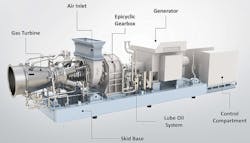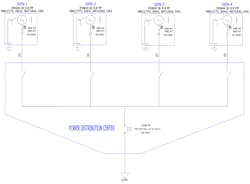Considering Options to Rising Energy Costs, Supply Outages
“Our electric utility rates are making us uncompetitive,” according to the v.p. of Engineering at a large ferrous foundry, explaining the reason for his call. “Could you provide on-site electric generation for our foundry?”
It is absolutely possible.
The foundry had been fighting the problem for years. It is located in a state that prevents shopping for electric energy supply; it has to buy electricity from the local utility. Indeed, its electric rate was very high in comparison to many other ferrous foundries.
It also had to accept the utility’s high electric “capacity” charges – which amounted to over half the foundry’s total electric bill each month. Not only would the local electric utility not provide any relief – it was implementing rate increases! Generating its own electricity seemed like the only option available to the foundry.
I asked the foundry executive, “How much of your load would you like to include in the on-site generation?”
“Eventually, probably all of it,” he said.
Things were so bad that the business was prepared to disconnect, to go “off the grid.” This foundry consumes enough electricity to power the needs of a small town, so this would be a significant requirement for on-site generating capability.
To be specific, more than 20 MW (megawatts) would be needed. Newer gas turbine technologies, specifically designed for industrial needs, were ideal for such a size load requirement.
As shown in the graphic, complete generators can be pre-built and tested in the factory. They are mounted on skids for transport and quick installation.We agreed that a modular and incremental approach would be best to phase-in such a transition, gradually, before achieving full independence from the grid. Then, we prepared an initial proposal that included a simple ROI, estimated at less than four years.
Our proposal included hardware, installation, and ongoing maintenance costs. Ongoing electric costs would fall dramatically and, once the ROI was achieved, subsequent savings would directly increase profits. The foundry could generate all its electric supply requirements on-site -- but it also could easily reconnect to the grid if needed.What about wind, solar, and battery technologies? These certainly can be included in your equipment configuration, but wind and solar are “intermittent” generators – the wind has to blow and the sun has to shine to create electricity. Battery technology has limited storage and output. Foundries need a predictable and reliable source of power and we feel that natural gas-powered generators are a better choice for metalcasters at this time.
It is not only large foundry operations that can benefit from on-site generation. In fact, additional options exist for mid-sized and smaller foundries.
Multiple generators can be configured to work together, providing enough generation for your peak load requirements, as well as scaling back to efficiently follow your lower loads. We have included a schematic of just such a system which provides peak generation of 1.4 megawatts, via a configuration of (4) 350 KW generators.
One option to explore is “energy-as-a-service”, by which no capital expenses are required by the power consumer, meaning by the foundry. If your cost structures and load profile qualify, some vendors will buy the generation equipment, and install and maintain it – as part of an energy services contract with you. You pay a pre-determined rate per kWh of electricity you consume from the generating equipment, at a rate that is less than what you’re currently paying your utility company. The vendor makes a profit because it can generate and deliver power cheaper than your electric utility. An added benefit is that you effectively have backup generation in the event of an emergency. Usually this service is set up to co-exist with power supplied by your electric utility; you simply use less power than is supplied by the utility. In this arrangement, known as peak-shaving, the generator(s) are programmed to run during the times when utility power costs are the highest (typically during daytime hours.)
Of course, another option is outright purchase of the equipment – which is the preferred choice of some manufacturers.
Newer on-site generating equipment may use natural gas or a variety of other fuels. Generating equipment can be configured to work in conjunction with the local grid, or to operate disconnected from the grid in “islanded” mode. The on-site generators also can be used for emergency power.
The electric industry is structured so that each state regulates the utilities operating within its boundaries.
Fortunately, nearly every state now allows you to generate your own electricity. And in most areas, rules for interconnecting to your utility have been changed to allow on-site generation. Some utilities even encourage it, because they see the potential for adding your generation capacity to the grid during emergencies. This is an arrangement known as Distributed Energy Generation (DER), and such voluntary programs can be financially rewarding to manufacturers – including foundries. Learn more at https://www.dsireusa.org/ .
On-site generation offers an alternative to escape the monopolistic structure of the power industry. This may be a viable way for many foundries to significantly lower electricity costs and reduce disruptions that may occur from grid-connected power. Having your own power source close to your manufacturing operations offers many benefits.
Your potential ROI depends on your local cost factors. We factor those into a no-cost, no-obligation analysis of your needs and a review of specific recommendations to meet them.
As electricity costs continue to increase, on-site generation can offer major cost savings and less disruptions to your production timetables.
Contact us for a confidential review of how on-site electric generation can help your foundry.
Brian Reinke, president of TDI Consulting, is an energy-cost saving consultant. Contact him contact him at [email protected].
About the Author
Brian Reinke
President
Brian Reinke, president of TDI Energy Solutions, is an energy-cost saving consultant. Contact him at 630-343-0971.


